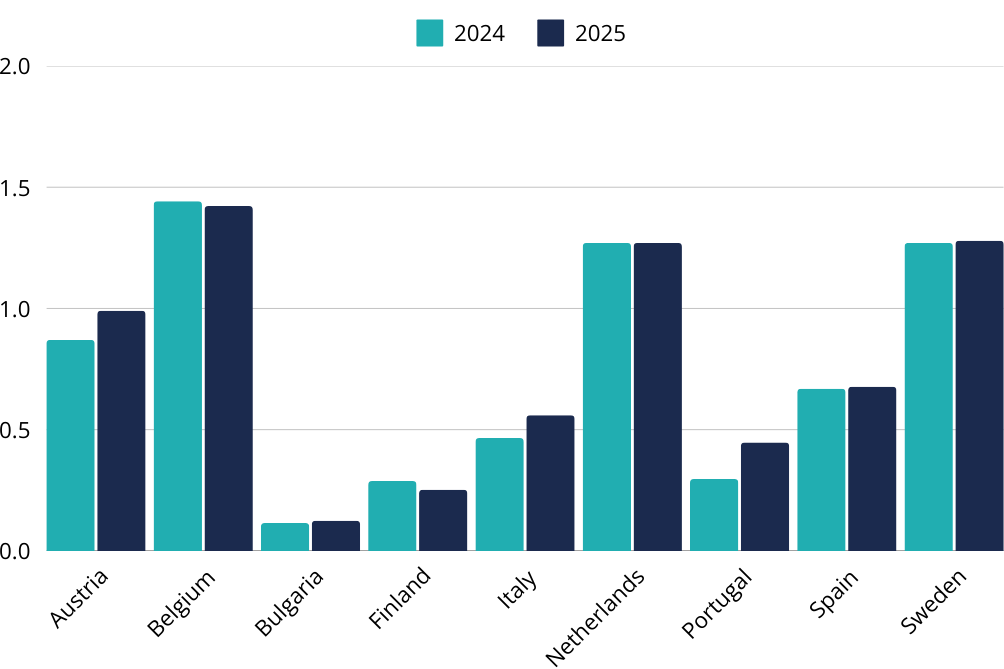.png)
Extended Producer Responsibility (EPR) fees continue to evolve across Europe, making it crucial for businesses to stay informed about cost changes. In this article, we compare EPR fee data from 2024 and 2025 across key European countries, highlighting emerging trends and significant insights. We also analyse how changes in fee structures—particularly regarding material costs—may impact businesses and their packaging strategies.
The graphs should be analysed with the following context in mind:
European Countries
The selected European countries met specific criteria, including:
Materials
The materials presented in the graphs represent the most commonly used types in FMCG packaging.
For countries that provide highly detailed material categories (e.g., different PET plastic types such as PET transparent, PET transparent coloured, and PET opaque), an average fee was calculated across all subcategories.
Each country has a unique fee structure influenced by:
Some countries classify materials with extensive granularity, while others use broader categories (e.g., grouping all plastics together).
Our analysis specifically focuses on household packaging, excluding commercial packaging. Additional graph descriptions are provided where necessary for clarity.

A one-size-fits-all approach to paper packaging no longer works. Businesses operating in multiple European markets must adapt their packaging strategies based on country-specific fee levels and regulations.
With countries like Sweden and Portugal nearly doubling their EPR fees for paper and cardboard packaging, companies must anticipate higher compliance costs.
This makes active monitoring of the fees and the implications on a company’s packaging portfolio necessary.
With EPR fees often favouring recyclable or lightweight materials, businesses can reduce costs by optimising their packaging design.

With aluminium EPR fees rising significantly in some markets, businesses should reassess their cost structures. The sharp increases, particularly in Austria and the Netherlands, highlight the need for companies to evaluate whether their aluminium packaging choices remain financially viable and cost-effective.
With increasing regulatory scrutiny, ensuring accurate EPR data reporting and compliance is also critical. Investing in a sustainable packaging management platform to track packaging obligations can streamline compliance efforts and prevent unexpected financial burdens.

Exploring alternative materials or optimising packaging design could help mitigate these additional expenses. Additionally, exploring eco-modulation opportunities—such as using higher recycled content or improving recyclability—could qualify companies for lower EPR fees in certain markets.

The rise in EPR fees for glass packaging across most European countries, with Portugal seeing an almost 200% increase, signals a growing financial burden for businesses relying on glass. While a few markets, such as Finland, have reduced fees and the Netherlands remains stable, the overall trend suggests that managing glass packaging waste is becoming more costly.
For businesses, this means reassessing their packaging choices and considering whether glass remains a viable option in key markets. Companies may need to explore cost-saving strategies, such as improving packaging design to reduce material usage or increasing the use of recycled glass.
Additionally, businesses operating across multiple countries should closely utilise an intuitive platform to monitor EPR fee structures to understand where glass packaging remains cost-effective and where alternative materials might offer financial and environmental advantages.

To conclude our visual presentation, we’ve chosen to show the fee development within one country by comparing materials.
Portugal was selected because it shows significant increases across most materials.
One of the most significant increases for plastic packaging which experienced a 51.05% spike.
Many EPR schemes are shifting toward eco-modulation, where fees are adjusted based on recyclability. The steep rise in fees for hard-to-recycle materials suggests that manufacturers and producers will increasingly be financially incentivised to invest in more recyclable and environmentally friendly packaging designs.
With EPR fees continuing to rise, brand owners need to:
EPR fees are not just another regulatory cost—they directly impact a brand’s bottom line. With rising fees across multiple European markets, failing to stay ahead of these changes can lead to significant financial strain.
Here’s why brand owners need to act now by adopting a centralised sustainable packaging platform:
Cost Efficiency: Monitoring EPR fees enables businesses to make smarter, cost-effective choices regarding packaging materials. Without active oversight, companies risk overpaying fees or missing opportunities for cost savings through eco-modulation incentives.
Regulatory Compliance: Each country applies different fee structures, making compliance complex. Businesses operating across multiple markets need a centralised approach to track obligations and avoid penalties.
Data-Driven Decision-Making: A centralised platform offers full transparency on EPR fees, helping businesses compare material costs, predict fluctuations, and adapt packaging strategies proactively.
Sustainability & Brand Reputation: Consumers are increasingly aware of sustainable practices. A well-managed, recyclable packaging portfolio not only reduces costs but also enhances brand credibility in environmentally conscious markets.
Without a clear strategy for tracking and managing these fees, businesses may find themselves reacting to financial losses rather than proactively optimising their packaging for cost efficiency and compliance.
From our interactions with companies, we have observed that some are at a disadvantage because they don’t:
However, the trends and insights showcased from the data show how important it is for companies to gain visibility for their portfolio.
This is where we come in. Our sustainable packaging management software ensures businesses stay informed and up-to-date by implementing the latest EPR fee structures. Users can quickly assess how their packaging is affected by the new rates and identify where they may be required to pay more.
By leveraging our intuitive software, companies can stay on track with evolving eco-modulation rules, assess potential risks of overpaying, and gain a clear understanding of new data requirements. This visibility enables businesses to make informed decisions and uncover potential cost-saving opportunities.
Our platform provides an efficient way to calculate EPR fees from the outset for new customers. Existing clients can easily compare 2025 fee changes and determine if immediate action is necessary.
Our current focus is on providing comprehensive assessments to support businesses in navigating the latest regulatory changes effectively.